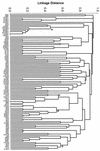Influence of recombination and niche separation on the population genetic structure of the pathogen Streptococcus pyogenes
- PMID: 11895961
- PMCID: PMC127860
- DOI: 10.1128/IAI.70.4.1971-1983.2002
Influence of recombination and niche separation on the population genetic structure of the pathogen Streptococcus pyogenes
Abstract
The throat and skin of the human host are the principal reservoirs for the bacterial pathogen Streptococcus pyogenes. The emm locus encodes structurally heterogeneous surface fibrils that play numerous roles in virulence, depending on the strain. Isolates harboring the emm pattern A-C marker exhibit a strong tendency to cause throat infection, whereas emm pattern D strains are usually recovered from impetigo lesions; as a group, emm pattern E organisms fail to display obvious tissue tropisms. The peak incidence for streptococcal pharyngitis and impetigo varies with season and locale, leading to wide spatial and temporal distances between throat and skin strains. To assess any impact of niche separation on genetic variation, the extent of recombinational exchange between emm pattern A-C, D, and E subpopulations was evaluated. Analysis of nucleotide sequence data for internal portions of seven housekeeping loci from 212 isolates provides evidence of extensive recombination between strains belonging to different emm pattern subpopulations. Furthermore, no fixed nucleotide differences were found between emm pattern A-C and D strains. Thus, despite some niche separation created by distinct epidemiological trends and innate tissue tropisms there is little evidence for neutral gene divergence between throat and skin strains. Maintenance of a relationship between emm pattern and tissue tropism in the face of underlying recombination suggests that tissue tropism is associated with emm or a closely linked gene.
Figures






References
-
- Anthony, B. F., E. L. Kaplan, L. W. Wannamaker, and S. S. Chapman. 1976. The dynamics of streptococcal infections in a defined population of children: serotypes associated with skin and respiratory infections. Am. J. Epidemiol. 104:652-666. - PubMed
-
- Bessen, D., and V. A. Fischetti. 1990. A human IgG receptor of group A streptococci is associated with tissue site of infection and streptococcal class. J. Infect. Dis. 161:747-754. - PubMed
-
- Bessen, D. E., J. R. Carapetis, B. Beall, R. Katz, M. Hibble, B. J. Currie, T. Collingridge, M. W. Izzo, D. A. Scaramuzzino, and K. S. Sriprakash. 2000. Contrasting molecular epidemiology of group A streptococci causing tropical and non-tropical infections of the skin and throat. J. Infect. Dis. 182:1109-1116. - PubMed
Publication types
MeSH terms
Substances
Grants and funding
LinkOut - more resources
Full Text Sources

